Physical Address
304 North Cardinal St.
Dorchester Center, MA 02124
Tumors involving the knee can be subdivided into osseous and soft tissue neoplasms, with either benign or malignant histology. This chapter describes the patient demographics and multimodality imaging characteristics of the most common tumors about the knee, organized by the classification set forth by the World Health Organization. The imaging features of these tumors are described based upon their characteristics exhibited on radiographs, computed tomography (CT), magnetic resonance imaging (MRI), sonography, and nuclear scintigraphy and F18-fluorodeoxyglucose positron emission tomography (FDG-PET).
An osteochondroma, also commonly referred to as an exostosis, is the most common primary bone tumor, accounting for approximately 25% to 50% of benign bone tumors and 10% to 15% of all bone neoplasms. Most cases present prior to 20 years of age and there is a 1.5 to 3.5 : 1 male-to-female predominance. Approximately 40% of osteochondromas occur around the knee. It is thought that trauma or congenital perichondral deficiency results in abnormal foci of metaplastic cartilage spontaneously giving rise to these benign entities ; however, some studies have demonstrated associated mutations of the exostosin-1 (EXT1) gene with solitary osteochondroma. There is also evidence associating hematopoietic stem cell transplant and radiation as other risk factors. Most cases are asymptomatic and are discovered incidentally. Although unusual, fracture through a pedunculated osteochondroma can compress the adjacent neurovascular structures and become symptomatic. Malignant transformation is exceedingly rare in solitary lesions; however, approximately 18% of cases are associated with multiple hereditary exostoses and an increased risk of malignant transformation of 3% to 25%.
An osteochondroma is a masslike structure with cortical and medullary continuity with the underlying bone. These lesions are often found in the metaphysis or metadiaphysis of long bones, can be sessile or pedunculated, and often protrude away from the adjacent joint ( Fig. 14.1 ). CT is very effective in demonstrating cortical and medullary continuity of the lesion with the parent bone, but assessment of the cartilage cap is variable. The cartilaginous cap typically has attenuation similar to adjacent soft tissue on CT, and is better visualized when the cap is mineralized. Sonography can provide accurate measurement of the cartilaginous cap with accuracy similar to MRI. The cartilage cap is normally hypoechoic relative to the adjacent tissues, but echogenic foci with posterior shadowing will be evident if cartilaginous calcifications develop.
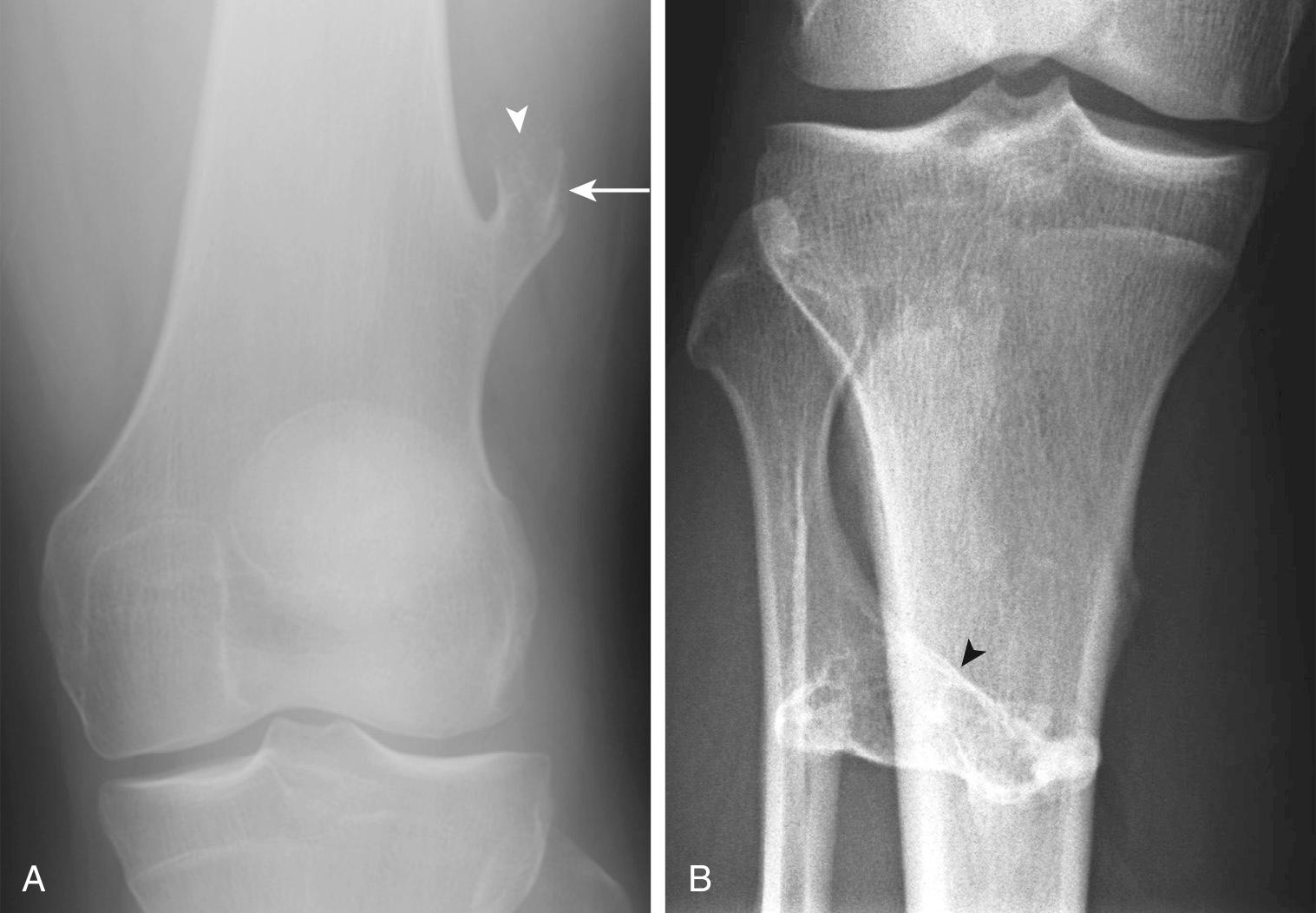
MRI can add significant value in the assessment of a symptomatic or worrisome osteochondroma. The cartilage cap thickness can be assessed on MRI, as it is almost isointense to normal hyaline cartilage on all sequences and possesses a surrounding perichondrium that is typically a thin hypointense rim ( Fig. 14.2 ). Cap thickness greater than 2 cm has been associated with significantly increased risk of malignant transformation to sarcoma. MRI is also excellent in assessing neurovascular complications of a symptomatic osteochondroma around the knee. The common peroneal nerve is the most commonly affected nerve in the presence of lateral lesions, and MRI may identify complications such as fatty muscular atrophy of the short head of the biceps femoris and the anterior and lateral compartments of the calf. Pseudoaneurysm formation can also occur due to chronic friction of an artery against the osteochondroma, with the popliteal artery most commonly affected. Symptomatic bursitis may also form adjacent to pedunculated lesions.
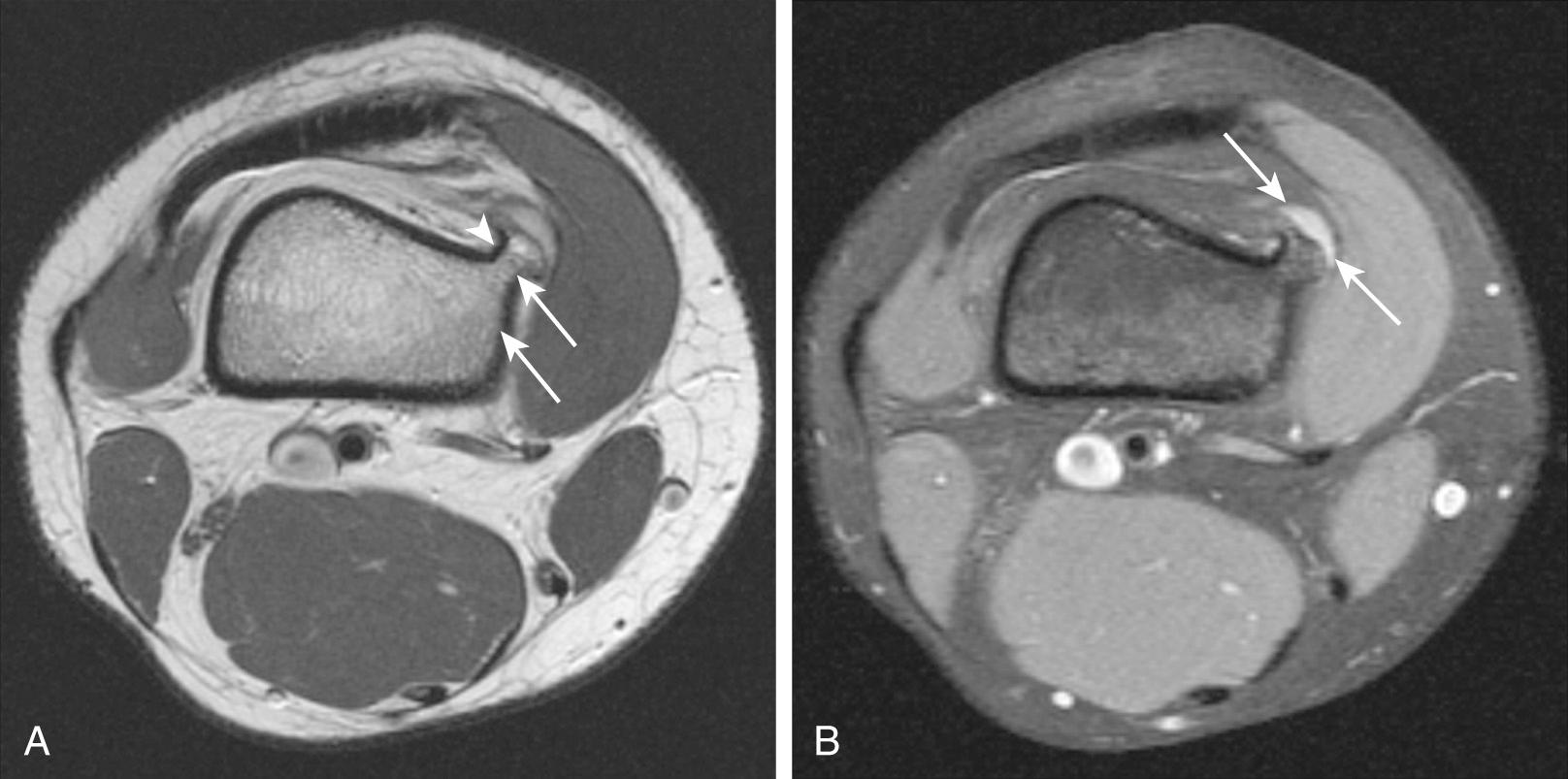
Enchondromas (also referred to simply as chondroma) are benign neoplasms composed of lobules of hyaline cartilage. The peak age of presentation ranges between the third and fourth decade of life. One study found an incidental prevalence of approximately 3%, although the true prevalence is unknown, given that most patients are asymptomatic. The most commonly involved osseous structures are the bones around the knee, most often the distal femur. Most enchondromas are centrally located and involve the metaphysis of long bones; however, cortical-based lesions are not uncommon. It is believed that enchondromas arise from the displacement of cartilaginous cells from the physis into the metaphysis during embryonic development. However, a recent retrospective analysis of 240 MRI exams of the knee failed to identify such displacement of cartilage into the metaphysis. Other evidence suggests that mutations in isocitrate dehydrogenase 1 and 2 (IDH1 and IDH2) may be associated with approximately half of all low-grade cartilaginous tumors. Although most enchondromas are solitary benign lesions with a low risk of malignant degeneration, patients with multiple enchondromas have a significantly higher risk of malignant transformation. Ollier disease is manifested by multiple enchondromas, with a risk of malignant transformation as high as 50%; the risk of malignant transformation is higher than 50% in patients with Maffucci’s syndrome, which is characterized by multiple enchondromas and soft tissue hemangiomata.
An enchondroma is evident on radiographs as a central geographic lytic lesion with variable mineralization and ill-defined or lobulated margins ( Fig. 14.3 ). Lesions often measure less than 6 cm in greatest dimension and mineralization can be seen in 95% of cases. Lesions may be difficult to detect if the margins have a wide zone of transition or there is an absence of matrix mineralization. Subtle endosteal scalloping, cortical thinning, and expansile remodeling of bone may occur. CT is superior to radiography in the detection of subtle findings such as occult matrix mineralization and endosteal scalloping. Endosteal scalloping with an enchondroma typically involves approximately 10% of the cortical thickness and extends for only a portion of the lesion.

MRI demonstrates a distinctive lobular conglomeration of tiny, clustered T2-hyperintense foci, reflective of the high ratio of water to mucopolysaccharide composition in the hyaline cartilage (see Fig. 14.3 ). On T1-weighted images, the enchondroma is isointense to skeletal muscle and intermixed with a high signal representing medullary fat (see Fig. 14.3 ). Murphey et al. have shown that MRI can help differentiate an enchondroma from a central chondrosarcoma in up to 90% of cases, based upon features such as depth and extent of endosteal scalloping. However, a more recent study demonstrated significant variability among radiologists' ability to differentiate enchondromas from low-grade chondrosarcomas, and the addition of MRI only slightly improved the accuracy of tumor grading. Skeletal scintigraphy demonstrates mild to moderate increased uptake relative to the iliac crest, and some authors have reported increased activity on FDG-PET imaging.
Periosteal chondromas are rare extracortical cartilaginous tumors that arise deep to the periosteum. The peak age of presentation is between the third and fourth decades. Periosteal chondromas most commonly involve the metaphysis of long bones, with the femur and tibia being the second most involved structures after the humerus.
These lesions typically demonstrate cortical scalloping, variable sclerosis, and a thin periosteal shell with or without central chondroid mineralization on radiographs and CT ( Fig 14.4 ). Periosteal chondromas are typically 2 to 2.5 cm in size; lesions greater than 3 to 5 cm are suspicious for periosteal chondrosarcoma. On MRI, these lesions demonstrate signal intensity isointense to hyaline cartilage on all sequences, and a thin hypointense rim on gradient echo sequences; peripheral and septal enhancement patterns can be seen with the administration of contrast.
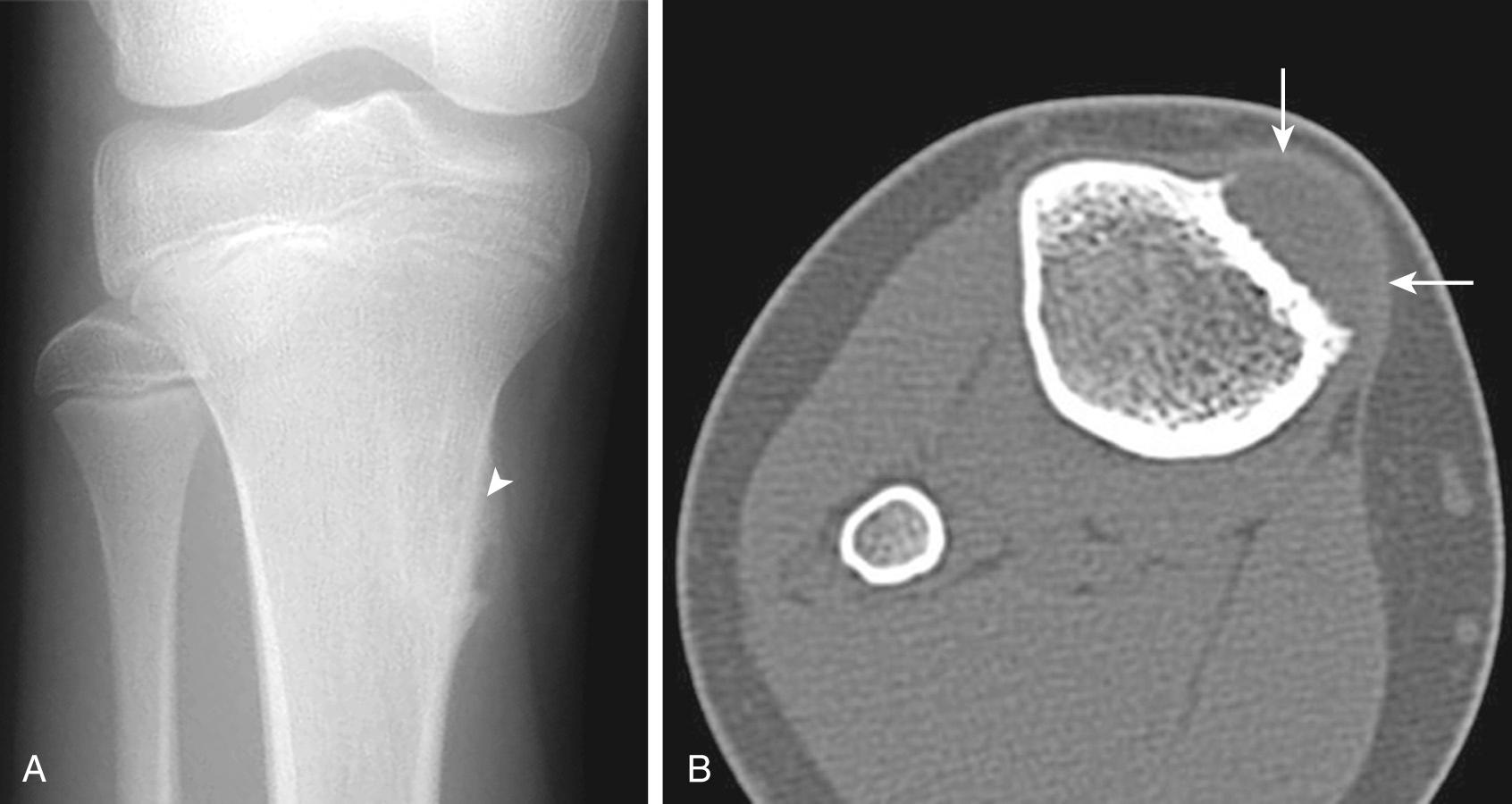
Chondroblastomas are rare benign tumors accounting for less than 2% of all primary bone tumors and approximately 5% of all benign bone tumors. Approximately 50% of chondroblastomas are located within the proximal tibia or distal femur; the majority involve the epiphysis or apophysis and commonly extend into the metadiaphysis. The mean age at presentation is approximately 20 years of age with a 2 to 3 : 1 male prevalence. Presenting symptoms most often include pain, local tenderness, and stiffness.
Chondroblastomas typically present radiographically as 1- to 4-cm lytic lesions with a thin, sclerotic margin. A lobular contour and matrix mineralization are present in 30% of cases. Lesions are classically located in the epiphysis of long bones adjacent to the growth plate, and approximately half of cases extend into the metaphysis ( Fig. 14.5 ). A solid periosteal reaction is present in up to 60% of cases. Nuclear scintigraphy can demonstrate increased uptake on vascular and delayed phases.
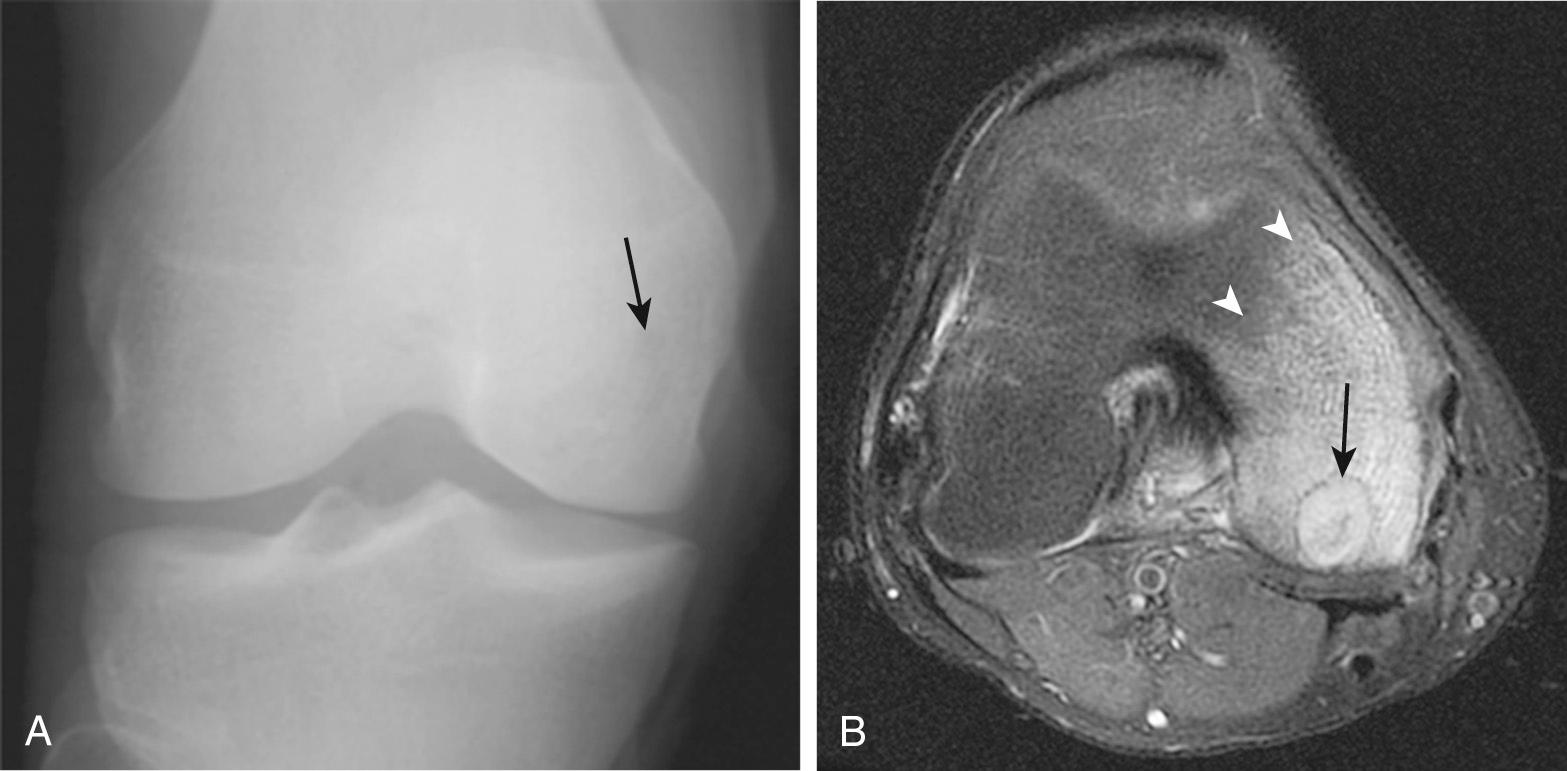
On MRI, the chondroblastoma typically demonstrates an intermediate T1-weighted signal and ranges from a hypointense to hyperintense T2-weighted signal with a lobular, thin hypointense margin (see Fig. 14.5 ). Prominent perilesional bone marrow edema is often present (see Fig. 14.5 ) along with periostitis, soft tissue edema, reactive joint effusion, and synovitis. Contrast-enhanced sequences demonstrate peripheral or septal enhancement. Secondary aneurysmal bone cyst (ABC) formation can occur in 15% of cases, with fluid-fluid levels identified on fluid sensitive sequences.
Nonossifying fibroma (NOF) and fibrous cortical defect are also known as metaphyseal fibrous defect and fibroxanthoma . Lesions are histopathologically identical, benign, self-limited defects that commonly occur in adolescents and children. Benign fibrous histiocytoma is also histopathologically indistinguishable from NOF and fibrous cortical defects and it is often a term used for cases with atypical radiologic appearance or clinical presentation. The peak age at diagnosis is within the second decade of life, and there is a 2 : 1 male predominance. These lesions are relatively common and may be present up to 36% of children. A large percentage of cases present around the knee, most commonly in the distal femoral metaphysis. Physical exam is often unremarkable; however, there may be occasional tenderness or pathologic fracture. These lesions can grow but eventually ossify starting from the diaphyseal side toward the epiphysis. Multifocal lesions may be present in 8% of patients and often should not give rise to concern in most cases. However, multiple fibroxanthomas are also a component of Jaffe-Campanacci syndrome, in addition to café au lait macules, decreased mentation, and hypogonadism or cryptorchidism.
Radiography, in conjunction with clinical history and physical exam, is often sufficient to make the diagnosis of fibroxanthoma. Classic radiographic appearance of fibrous cortical defect is a cortically based lytic lesion with a thin sclerotic rim. These lesions typically have an oval shape and parallel the long axis of the bone. NOF is a term typically used to describe larger defects that extend into the medullary cavity ( Fig. 14.6 ).
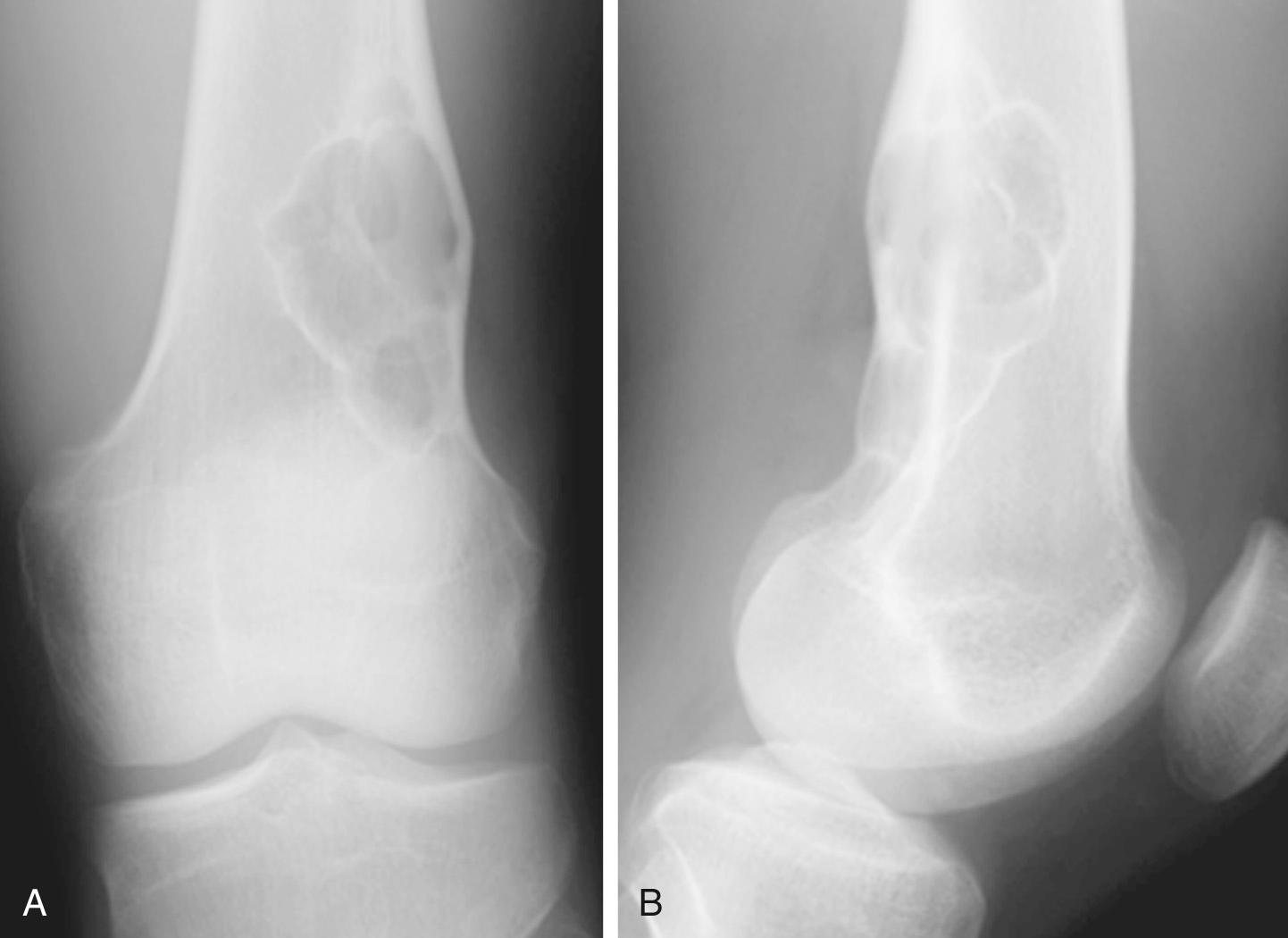
CT can occasionally better characterize indeterminate lesions, but is more commonly used for preoperative planning for large lesions located in weight-bearing regions that are at risk for pathologic fracture. On MRI, fibroxanthomas are most frequently located in the metaphysis, are eccentrically located, and have well-defined scalloped margins ( Fig. 14.7 ). T2-weighted signal characteristics are variable, with areas of hyperintense, intermediate, and low-signal intensity due to the fibrous matrix and mineralization (see Fig. 14.7 ). Occasionally, areas of fat-isointense signal or secondary ABC formation may be present. Contrast-enhanced images most often demonstrate heterogeneous, intense enhancement. Nuclear scintigraphy can help differentiate the activity within the lesion as uptake varies through the evolution of these lesions, but it is not routinely performed as part of the diagnostic workup. Intense uptake indicates an active lesion or possible associated fracture. Intermediate uptake is present during the healing process as the lesion ossifies, but healed lesions should demonstrate no increased radiotracer uptake.
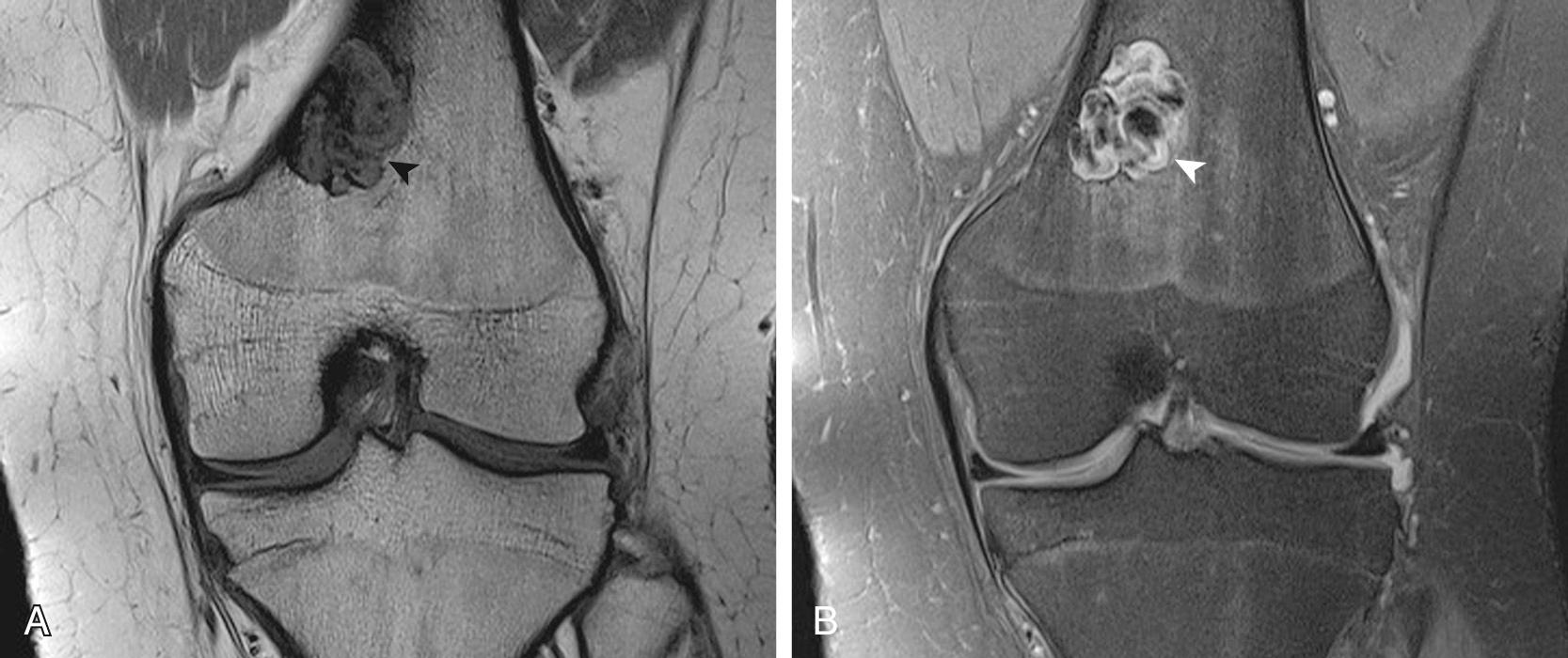
The cortical desmoid is a benign, self-limited lesion considered to be a variant of NOF. The peak age at time of diagnosis is in the second decade of life with a 3 : 1 male predominance. It is believed that cortical desmoids arise from repeated traction on the insertion of the adductor magnus aponeurosis or the origin of the medial head of the gastrocnemius on the posterior femoral metaphysis. Most cases are asymptomatic, although mild associated pain and localized swelling may occur.
The cortical desmoid is best viewed on external rotation radiographs of the femur, and typically presents as a small radiolucent, saucer-shaped lesion or region of focal cortical roughening ( Fig. 14.8 ). The typical location for cortical desmoids is within the posteromedial femoral metaphysis. These findings, in conjunction with a physical exam and clinical history, are often sufficient for diagnosis. CT may be useful to better visualize the lesion in cases where radiographs are inconclusive, and may demonstrate a concave or convex lesion in the axial plane (see Fig. 14.8 ).

MRI can also help in indefinite atypical cases and often demonstrates low to intermediate signal intensity on T1-weighted and intermediate to high intensity on T2-weighted sequences, often with surrounding hypointensity representing a sclerotic rim (see Fig. 14.8 ). On contrasted sequences, these lesions demonstrate intense enhancement. MRI can also help delineate the relationship of the cortical desmoid to the insertion of tendons. Nuclear scintigraphy demonstrates findings similar to NOF in cortical desmoid and uptake is contingent upon the activity of the lesion. Single-photon emission computed tomography (SPECT) has been reported to have greater accuracy in the detection of small lesions, even in cases where bone scans are negative.
Osteoid osteomas are the third most common benign bone tumor, comprising 10% to 12% of all benign and 2% to 3% of all primary bone neoplasms. It is characterized by a central nidus composed of an osteoid matrix and osteoblasts surrounded by sclerosis. Approximately 85% of osteoid osteomas occur between the ages of 5 and 24 years, with a 1.6 : 1 to 4 : 1 male predominance, and most cases occur in Caucasian populations. Approximately 50% of these tumors occur in the femur and tibia. The classic clinical presentation is pain that worsens at night and is alleviated with nonsteroidal anti-inflammatory drugs (NSAIDs). The pain is often described as deep, achy, intense, and intermittent and may last weeks to months before the diagnosis is made. The pathogenesis of these lesions is poorly understood, but there is evidence that local increased levels of prostaglandins, prostacyclin, and cyclooxygenase-2 play a role in the localized inflammation and vasodilation.
The radiographic appearance of the osteoid osteoma is contingent upon the location of the lesion. Three predominant patterns have been described in the literature—cortical, medullary, and subperiosteal. Cortical lesions are the most common, representing about 75% of all osteoid osteomas. These are characterized by cortical lucent lesions less than 2 cm with or without calcification within the central nidus. Sclerosis surrounding the nidus may be sufficiently thick to opacify the central lucency ( Fig. 14.9 ). Medullary lesions account for approximately 20% of all osteoid osteomas and typically form some eccentric sclerosis on the adjacent cortex. Subperiosteal lesions account for less than 5% of all osteoid osteomas and form soft tissue masses adjacent to the bone with typically no sclerosis of the adjacent osseous structures. Intra-articular osteoid osteomas can occur, but are uncommon in the knee.
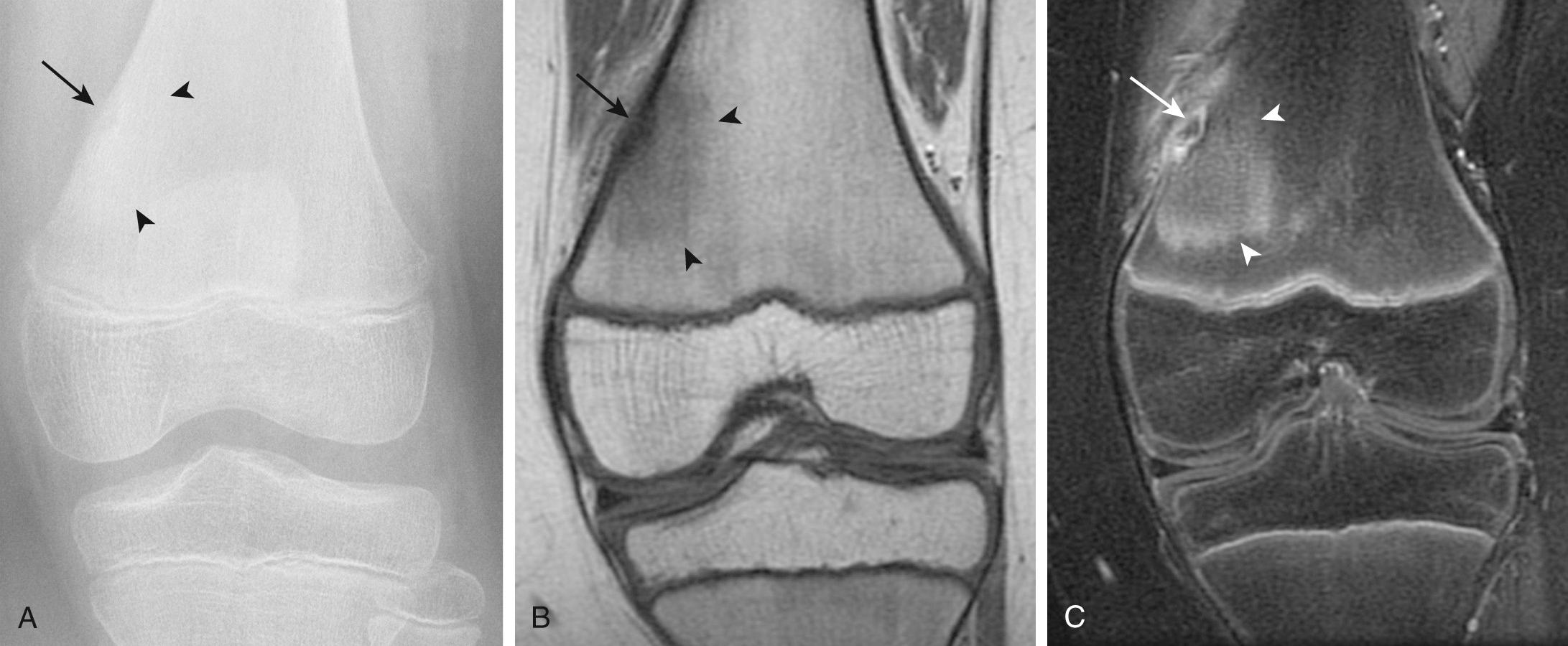
CT is the modality of choice in the diagnosis of osteoid osteoma with numerous studies showing the superiority of CT to MRI. The nidus of the osteoid osteoma is of low attenuation (isodense to soft tissue) and surrounded by sclerosis. Focal calcifications can be present within the nidus and may be punctate, amorphous, or ringlike ( Fig. 14.10 ). The “vascular groove” sign has been found to be a relatively sensitive and specific CT sign for osteoid osteoma, with the identification of linear vascular channels surrounding the tumor.
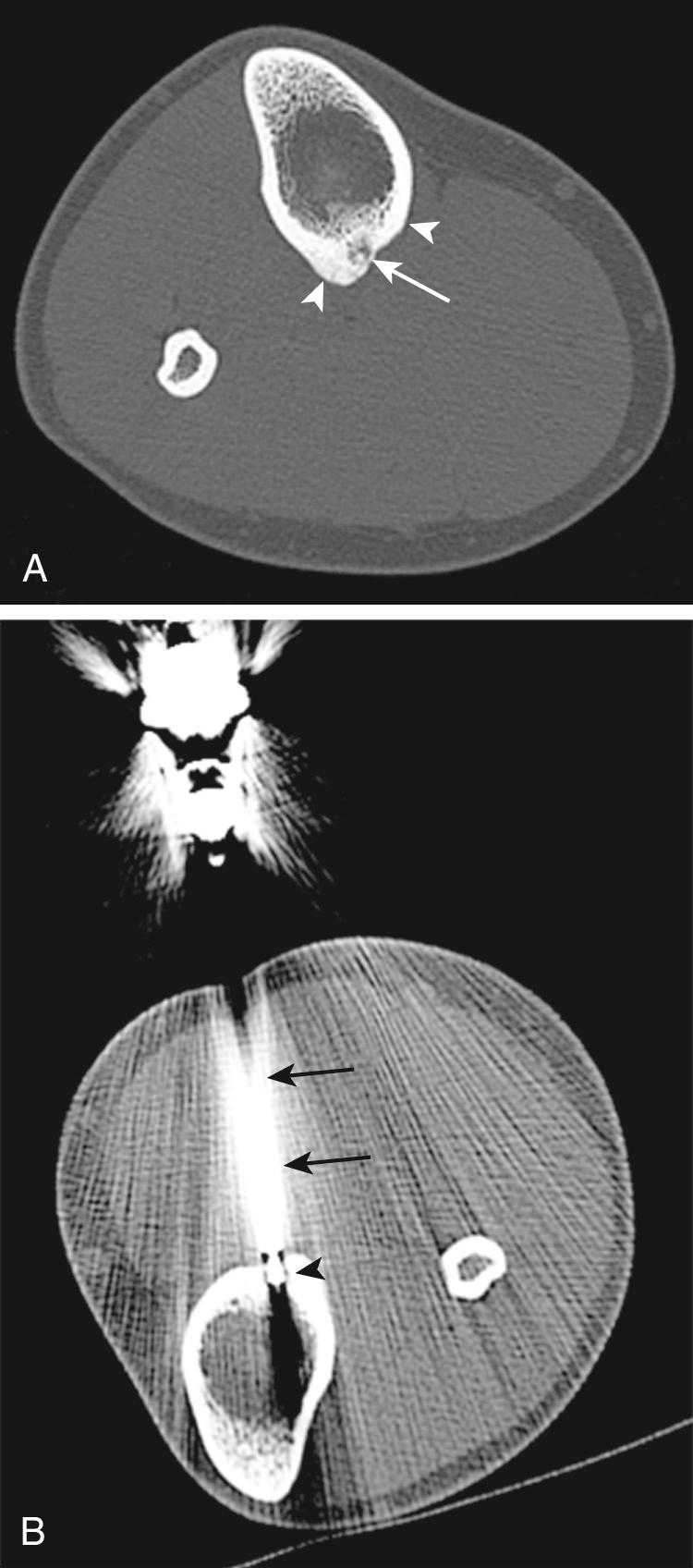
The appearance of an osteoid osteoma on MRI is variable. In general, these lesions have a low to intermediate signal on T1-weighted and an intermediate to increased signal on T2-weighted images (see Fig. 14.9 ). Associated bone marrow and soft tissue edema is not an uncommon finding and can mimic a malignant process (see Fig. 14.9 ). Enhancement is also variable, but the central nidus and surrounding edema typically enhance.
Nuclear scintigraphy is almost 100% sensitive in the detection of osteoid osteoma. These neoplasms exhibit increased uptake on all three phases and classically demonstrate a double-density sign. This is characterized by highly intense central uptake, relating to the highly osteoblastic nidus, surrounded by a zone of less-intense uptake, which corresponds to the bone's response to the tumor. Pinhole magnification has been shown as superior to planar imaging in demonstrating the double-density sign. Sonography has limited usefulness in the evaluation of osteoid osteomas, but it has been used in the assessment of the vascular supply to these tumors. The feeding artery may be identified with color Doppler; however, the use of ultrasound has largely been replaced by other modalities.
The predominant differential consideration when diagnosing osteoid osteoma is osteoblastoma. These two entities bear multiple similarities and are sometimes considered to be within the same pathologic spectrum. Osteoblastomas are traditionally expansile lesions larger than 2 cm that may grow over time, whereas osteoid osteomas are nonprogressive. Osteoblastomas can also present with pain but do not usually respond to NSAIDs.
The giant cell tumor (GCT) of bone is generally a benign entity histologically characterized by multinucleated giant cells superimposed on a background of mononuclear stromal cells. GCTs account for approximately 20% of all benign bone tumors and 5% of all primary bone neoplasms. Lesion prevalence peaks in the third decade and there is a slight 1.2 : 1 female predominance. Approximately 50% to 65% of cases occur around the knee. Patients often present with pain. Pain can be associated with activity or can occur at rest, and is due to mechanical failure from bone destruction, which may predispose to pathologic fracture, and expansion of the periosteum. The exam may reveal direct tenderness to palpation, swelling, joint effusion, and gait abnormalities.
Radiographs demonstrate an eccentric lytic lesion involving the subchondral bone with well-defined, nonsclerotic margins ( Fig. 14.11 ). Ninety percent of cases are metaphyseoepiphyseal in location. Locally aggressive features include cortical destruction and expansile remodeling, wide zone of transition, and extra-osseous soft tissue extension. Periosteal reaction is not a common finding with these tumors. Initial radiographs often show these classic findings and biopsy is performed to confirm the diagnosis. Malignant transformation is exceedingly rare, with a prevalence of approximately 1% of all GCTs. Malignant GCTs of bone may also exhibit cortical permeation and soft tissue extension, preventing reliable radiologic differentiation between benign and malignant lesions.
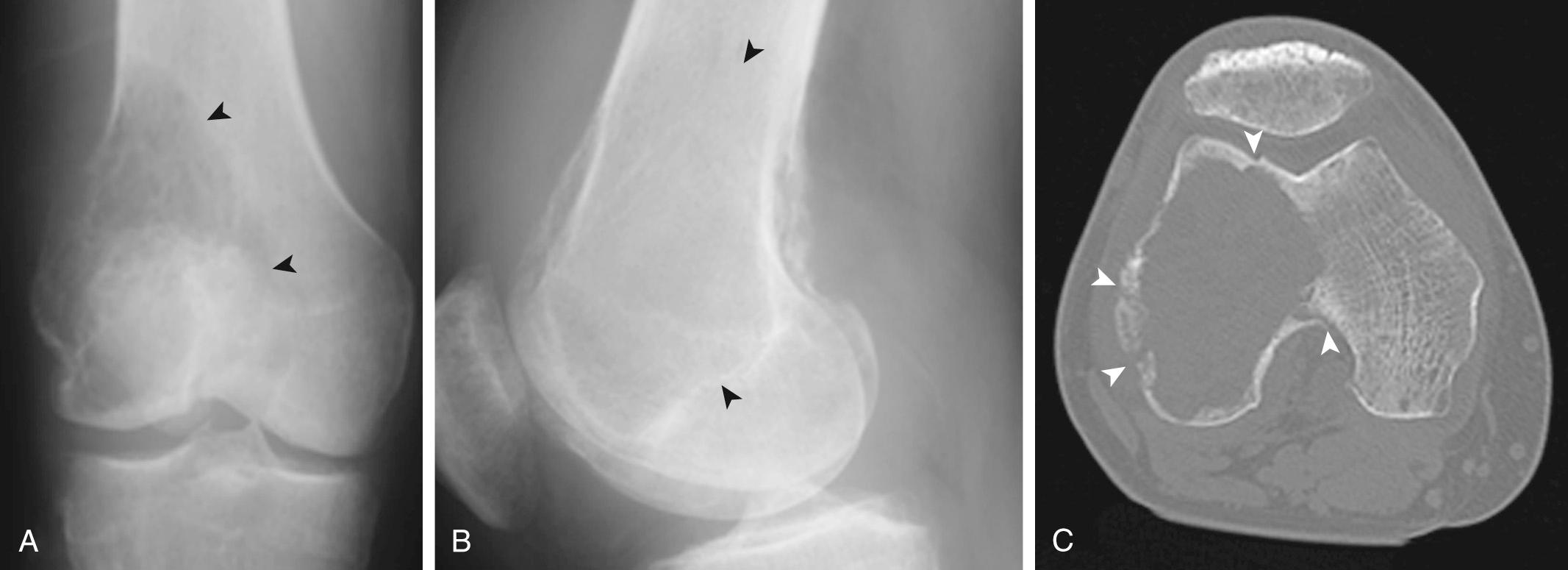
CT allows for better visualization of pathologic fractures, cortical destruction/thinning, expansile remodeling, and periosteal reaction (see Fig. 14.11 ). GCT soft tissue density is measured on CT, and soft tissue extension is seen in up to 44% of cross-sectional studies. MRI shows the classic eccentric, metaphyseoepiphyseal location of the GCT, low to intermediate T1-weighted and increased T2-weighted signal intensity, areas of blooming on gradient echo imaging, and enhancement ( Fig. 14.12 ). There may also be fluid-fluid levels from secondary ABC development present in approximately 14% of cases. Nuclear scintigraphy typically demonstrates peripheral, increased uptake with central photopenia (“donut sign”). However, this is not a specific finding and can be seen in ABCs and telangiectatic osteosarcomas. There is frequently increased uptake in the adjacent joint due to increased blood flow and local demineralization secondary to disuse, and uptake does not suggest tumor extension into the joint.
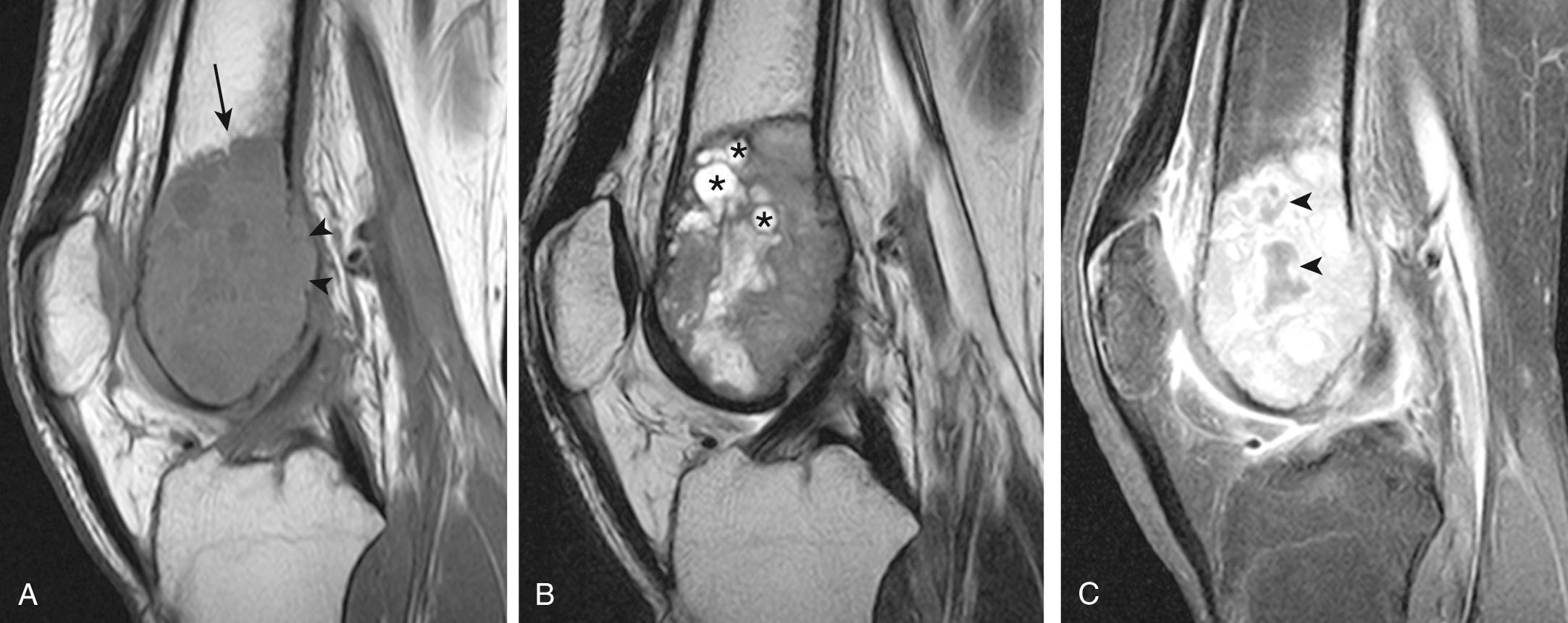
GCTs of the bone have been reported to metastasize to the lungs in 1% to 6% of cases. These lesions are thought to arise through hematogenous seeding of the GCT. Pulmonary metastases have imaging characteristics similar to the primary bone tumors, have benign histology, and may not require treatment.
The myeloma is the most common primary bone tumor and predominantly affects patients in the seventh decade of life. Myelomas are characterized by anomalous proliferation of plasma cells that produce monoclonal immunoglobulins. These cells can infiltrate bone marrow and replace the normal marrow environment, resulting in abnormal hematopoiesis. The classic findings of myeloma consist of hypercalcemia, renal insufficiency, anemia, and lytic bone lesions; pathologic fractures also occur and the myeloma entity carries significant risk of morbidity and mortality.
Initial evaluation of a myeloma often involves a full skeletal survey, including views of the skull, spine, ribs, femurs, and knees. The long bones are affected in approximately 25% of patients. Radiographic findings may include cortical thinning with or without discrete lytic lesions ( Fig. 14.13 ) caused by abnormal bone marrow proliferation with resultant destruction of bone. Approximately 80% of patients have detectable abnormalities on skeletal survey, however radiographs have significant diagnostic limitations. Lesions may not be apparent until there is 30% to 50% loss of the normal bone density, and there is a false-negative rate of 30% to 70%.
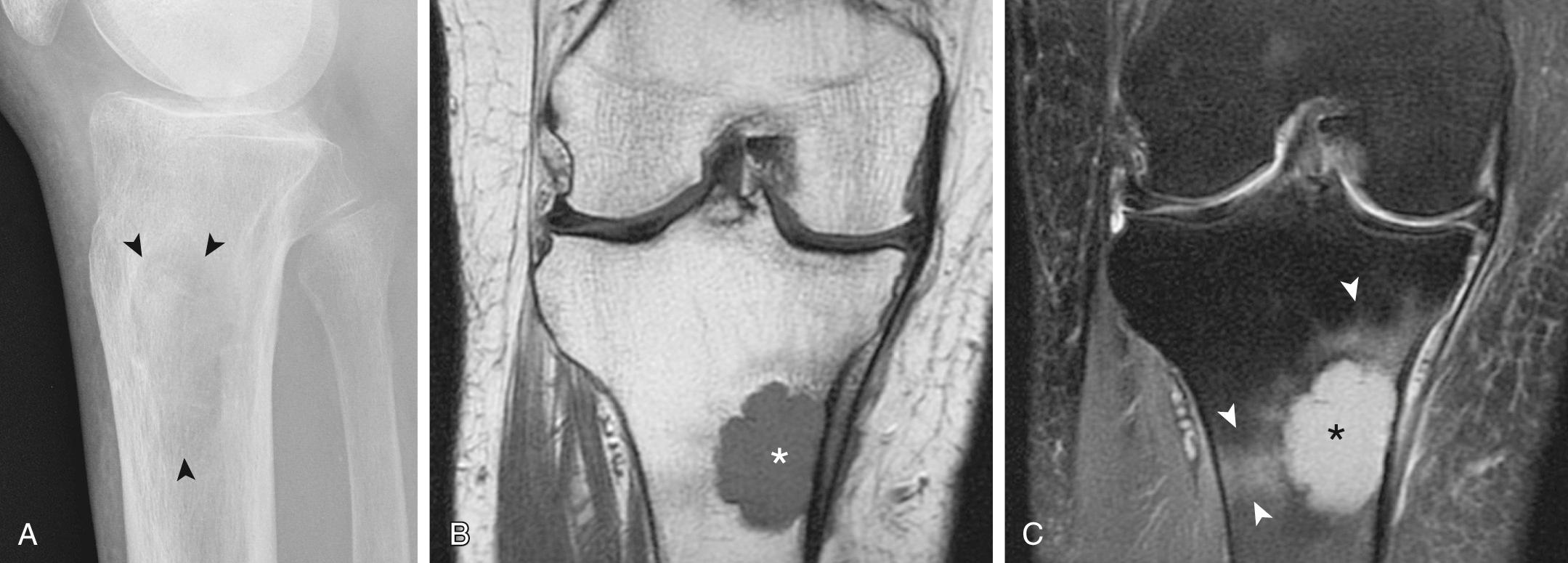
Multidetector CT allows for increased sensitivity in the detection of lytic lesions when compared to radiography and can further delineate areas at risk for pathologic fracture. In conjunction with MRI, CT improves staging over any independent modality. One of the primary drawbacks to whole-body CT is radiation dose; however, low-dose CT protocols have been developed for use in the screening of myeloma. Whole-body MRI examination is being used more extensively in the imaging workup of myeloma, and has been shown to be effective in detection of lesions in the axial and appendicular skeleton. Bone marrow involvement can be identified by detection of a hypointense signal relative to the normal fatty marrow on T1-weighted images and hyperintensity on T2-weighted images (see Fig. 14.13 ). Untreated lesions also exhibit diffuse contrast enhancement. However, these findings are nonspecific and can be seen with lymphoma, leukemia, and metastatic disease. The number and pattern of lesions has been correlated with treatment outcomes. There are four predominant patterns seen in MRI with myelomas:
Normal marrow pattern
Micronodular, also referred to as a variegated or salt-and-pepper pattern
Focal pattern
Diffuse pattern
Normal and micronodular patterns have been associated with stage I disease, whereas focal and diffuse patterns are more frequently associated with stage II or III disease. Currently there are no universally accepted scanning recommendations with multiple whole-body MRI protocols using many different scanning sequences in the literature. At some institutions, whole-body coronal and sagittal T1 and short tau inversion recovery (STIR) images are used as the standard protocol. Newer emerging MR techniques are being researched including dynamic contrast-enhanced (DCE) MRI and diffusion-weighted imaging but they are not currently used in widespread clinical practice. *
* References , and .
FDG-PET/CT is a useful tool for the staging and prognosis of myeloma. The CT component allows for detection of osseous lesions, as described previously, and PET aids in the delineation of medullary lesions without associated bony changes and extra-osseous involvement. Active lesions are characterized by increased FDG uptake. Patients with more than three focal lesions generally have a worse survival rate when compared to patients with three or fewer lesions. Lesions smaller than 10 mm may be difficult to detect and yield a false-negative result when using a standardized uptake value (SUV) threshold of 2.5. Corticosteroid treatment may also result in false-negative results if not stopped at least 5 days prior to the examination. FDG-PET/CT may also be useful in post-treatment monitoring, with decreased uptake after successful treatment. Furthermore, it is noteworthy that patients with monoclonal gammopathy of undetermined significance (MGUS) do not have increased uptake as seen in patients with myeloma, allowing for distinction between the two entities on PET.
The osteosarcoma is a malignant, osteoid-forming bone tumor that is the second most common primary bone tumor, and the most common primary bone tumor in children. Osteosarcomas are most commonly located within the central medullary canal of long bones, but can also occur within the cortex, periosteum, and soft tissues. There are multiple syndromes and genetic mutations that can predispose to the development of osteosarcoma including Li-Fraumeni syndrome; Rothmund-Thomson syndrome; p53, retinoblastoma susceptibility (Rb) and murine double minute 2 (MDM2) mutations; and heterozygosity in chromosomes 3q, 13q, and 18q. All the osteosarcoma subtypes are listed in Table 14.1 , but only the more common subtypes will be discussed.
|
Become a Clinical Tree membership for Full access and enjoy Unlimited articles
If you are a member. Log in here